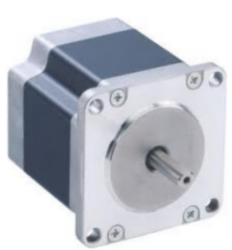What is a Stepper Motor?

A stepper motor (also called simply a stepper) is a digitally controlled brushless motor that rotates a specific number of degrees (a step) every time a clock pulse is applied to a special translator circuit that is used to control the motor.
The number of degrees that the motor turns per step varies for each motor. The number of degrees can be as small as 0.72° per step or as large as 90° per step. Common general-purpose resolutions are 15° and 30° per step.
Unlike RC servos, stepper motors can rotate a full 360° and can be made to rotate in a continuous manner as well like a dc motor, although it has a lower maximum speed. It can function in a continuous manner with the aid of proper digital control circuitry.
An advantage of stepper motors over dc motors is that they provide a large amount
of torque at low speeds. Torque is the ability of a force to cause rotation. So with stepper
motors providing high torque at low speeds, it can be used efficiently in applications where
low speed and high-precision control is necessary. As an example, they are used in printers to
control paper feed and also in plotter- and sensor-positioning applications.